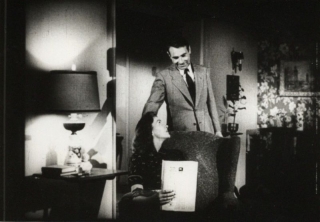Date: 16 October 2001 | Season: Cinema Auricular
CURRENTS OF CHAOS: ELECTRO-SHOCK CINEMA
Tuesday 16 October 2001, at 6:15pm
London Barbican Cinema
Confusion … delusion … retribution. Electronic feel flows as your nervous system careens into overdrive. From the chaotic Outer Space to the sublime #11, five films plugged directly into the National Grid to give maximum audio-visual pleasure (or pain). Throbbing, shouting, screaming, smashing … This is not for the faint-hearted, but what doesn’t kill you makes you stronger.
Note: Where the soundtrack is not by the filmmaker, the composer’s name is in square brackets
Peter Tscherkassky, Outer Space, 1999, 10 min
Hollis Frampton, Critical Mass, 1971, 25 min
Martin Arnold, pièce touchée, 1989, 15 min
Paul Sharits, Axiomatic Granularity, 1972-73, 20 min
Joost Rekveld, #11 (Marey<->Moiré), 1999, 21 min [Edwin van der Heide]
PROGRAMME NOTES
CURRENTS OF CHAOS: ELECTRO-SHOCK CINEMA
Tuesday 16 October 2001, at 6:15pm
London Barbican Cinema
OUTER SPACE
Peter Tscherkassky, Austria, 1999, b/w, sound, 10 min
A woman, terrorised by an invisible and aggressive force, is also exposed to the audience’s gaze, a prisoner in two senses. Outer Space agitates this construction, which is prototypical for gender hierarchies and classic cinema’s viewing regime, and allows the protagonist to turn them upside down. Flickering images, everything crashes, explodes; perforations and the soundtrack are engaged in a violent struggle. The story ends in the woman’s resistant gaze. (Isabella Reicher)
CRITICAL MASS
Hollis Frampton, Critical Mass, USA, 1971, b/w, sound, 25 min
As a work of art I think Critical Mass is quite universal and deals with all quarrels (those between men and women, or men and men, or women and women, or children, or war). It is war!…It is one of the most delicate and clear statements of inter-human relationships and the difficulties of them that I have ever seen. It is very funny, and rather obviously so. It is a magic film in that you can enjoy it, with greater and greater appreciation, each time you look at it. Most aesthetic experiences are not enjoyable on the surface. You have to look at them a number of times before you are able to fully enjoy them, but this one stands up at once, and again and again, and is amazingly clear. (Stan Brakhage)
pièce touchée
Martin Arnold, Austria, 1989, b/w, sound, 15 min
While Muybridge seems to have believed his photographs analysed the motion of ‘reality’ Arnold is well aware that piéce touchée explores a Hollywood cliché that is, at most, only a pretence of reality: a cinematic gesture that polemicises a culturally approved relationship between the genders. Arnold uses his optical printer to lay bare the gender-political implications of the husband’s arrival and to transform this gesture, which has become nearly invisible to most viewers, into a phantasmagoria of visual effects that would make any trick-film director proud. (Scott MacDonald)
AXIOMATIC GRANULARITY
Paul Sharits, USA, 1972-73, colour, sound, 20 min
In Spring 1972 a series of analyses of colour emulsion ‘grain’ imagery was undertaken (the word ‘imagery: is significant because only representations of light sensitive crystals, or ‘grain’, remain on a developed roll of colour film). The investigation is preliminary to the shooting of Section 1 of “Re: Re: Projection”, Variable Emulsion Density, wherein attempts to construct convincing lap dissolves of solid colour fields with straight fine grain Ektachrome ECO proved unsatisfactory. It was thought that more ‘grainy’ colour field interactions might adequately prevent the undesirable smoothness of hue mixture resulting from ECO superimposition. A discreteness of individual hues, during superimposition, is necessary; then, a switch to Ektachrome EF, pushed extra stops in development, seemed somewhat reasonable. Still, unexpected (colour blurring) problems arose and it was clear that a ‘blow up’ of the situation was called for; a set of primary principles was needed and, particle by particle, Axiomatic Granularity seemed to formulate itself. Its ‘structure’ lacks normative ‘expressive intentionality’.
#11 (MAREY<->MOIRÉ)
Joost Rekveld, Netherlands, 1999, colour, sound, 21 min [Edwin van der Heide]
A film in which all images were generated by intermittently recording the movement of a line. It is a film about the discontinuity that lies at the heart of the film medium. After making films #3 and #5 I was thinking about other methods to generate images by distributing light across film frames in perverted ways. One idea that came to mind was to record a continuous movement with long exposures like I had been doing before, but to interrupt these exposures many times to generate visual patterns. This would create interesting interferences between the motions involved. The other development was my increasing interest in the technological history of film. I had been looking for a kind of ‘pure’ film: images the film apparatus would come up with if left alone, as it were. While thinking about ‘pure’ film I started to look towards the historic origins of film and new media in general. Besides “#11” this led to experiments I did with various mechanical installations using nipkow discs or anorthoscopes. In order to make the film I constructed a machine with the help of which I was able control three movements: the movement of the film in the camera , the rotation of a shutter in front of the lightsource, and the movement of a line in front of the camera. The interferences possible between these three motions are the material I used to compose #11. For every section of the film I recorded a set of high contrast black and white originals which I used in the optical printer to create interference images in colour.
Back to top
